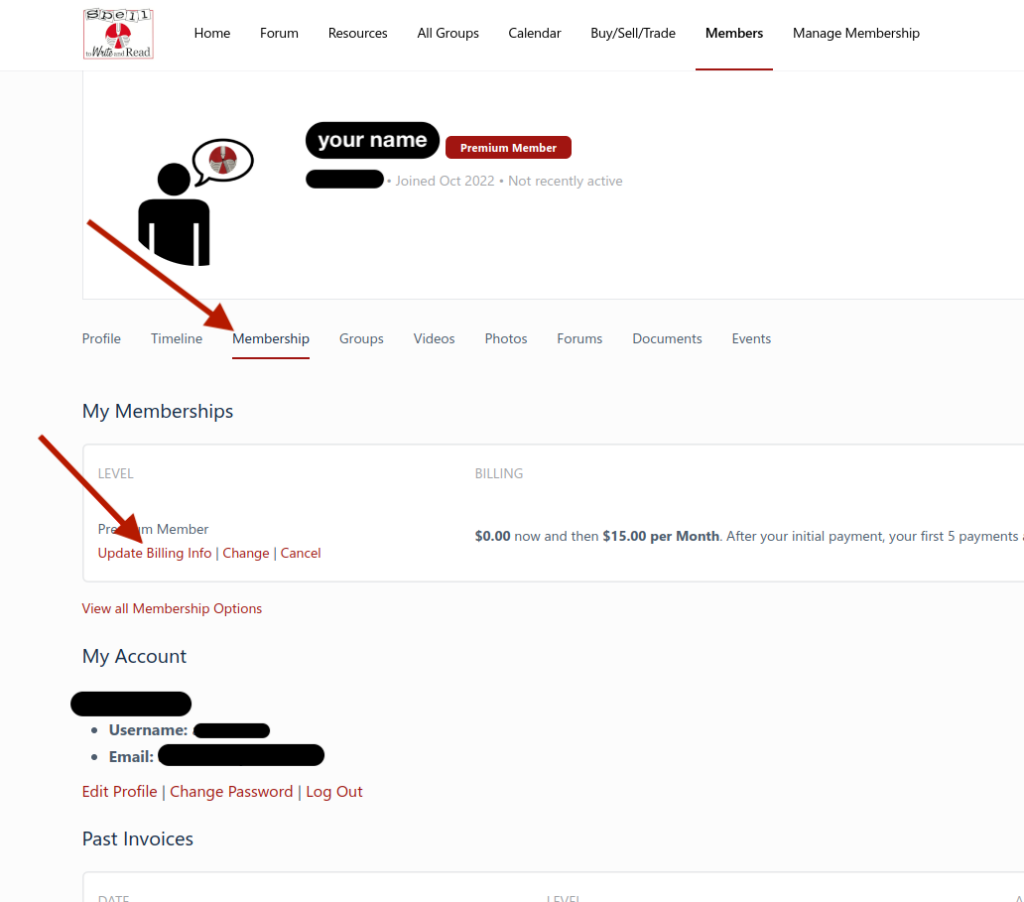Spell to Write and Read Curriculum
Store
SWR Forum
SWR Resource Center
Membership
SWR App
Miscellaneous
Spell to Write and Read Curriculum
Why should I choose SWR?
The ABCD’s of SWR
SWR Acronyms, ‘Breviations, Conventions, and Definitions
Ironic, isn’t it, that we promote teaching children to read by not teaching them the names of the letters and yet we use them here to describe the language of SWR? Acronyms, Abbreviations, Conventions, and Definitions (AACD!?!) just didn’t look quite right so please indulge me here.
Store
Will you carry other SWR and Sanseri products in addition to what is in your store?
Yes! Other items previously available from Back Home Industries will be added incrementally. Please send us an email to let us know which products you are seeking: info@spelltowriteandread.com
I can’t find the SWR Core Kit in your store. Is it still available?
The SWR Core Kit is now available as individual items. The main reason for this is to keep the cost as low as we can for you. If we sold the items as a kit, we would need to raise the price in order to pay someone to pre-package them. If you order one of each of the following, you will have everything that was formerly sold as the SWR Core Kit:
- Spell to Write and Read Teacher’s Manual
- The Wise Guide for Spelling
- 70 Basic Phonogram Cards (Original Small Size)
- Spelling Rule Cards (Original Small Size)
- Seventy Basic Phonogram CD
Another advantage of purchasing the items individually is that you may select whichever size of the card sets that best meets your needs. Here are the links to the larger cards which work well in classrooms and are great for playing games at home!
Please note that you will also need a Learning Log for each of your students and one for yourself.
When will my order ship?
Orders typically ship within 48 business hours.
Order shipped via USPS will not be trackable and may not be insured. If you need a trackable, insurable shipping method, please email sales@spelltowriteandread.com.
Why do your shipping and handling costs seem so high?
Our shipping cost is calculated as close to exact as possible using USPS software. Added in is a $10 per order handling charge from our fulfillment center. This covers the materials for shipping your products as well as the labor involved in selecting your items, packing them, and preparing the package to ship.
We hope to add more carriers in the future in order to offer more shipping options.
How do I cancel my order?
If your order has not yet shipped and you wish to cancel it, write to sales@spelltowriteandread.com to make a request. Please include your order number. Beginning June 15, 2023, payment processing fees will be subtracted from refunds.
What is your return policy?
Returns from retail customers are accepted with the following conditions: Items must arrive in new condition; please pack them carefully. If items do not arrive in new condition, a less-than-full refund will be offered. Buyer pays return shipping. The cost of the items will be refunded minus any payment processing fees. Original shipping and handling charges will not be refunded.
Where else can I buy SWR products?
I’m glad you asked! Check out this Where to Buy page!
Are any SWR products available as digital downloads?
The author has not authorized digital products at this time.
Will you carry Cursive First or the WISE Guide Enrichment Activity Worksheets?
Liz Fitzgerald has retired as an SWR Endorsed Trainer. Her products Cursive First and both volumes of WISE Guide Enrichment Activity Worksheets were self-published and not official Spell to Write and Read materials. Once her remaining inventory is depleted, she will no longer be selling these products as her permission to publish works based on Spell to Write and Read has expired.
Will you carry Advanced Phonogram Cards?
Advanced Phonogram cards are not an authorized Spell to Write and Read product.
SWR Forum
What are the Forum Guidelines?
By interacting with this website, you agree to the following Guidelines:
- Use kind words. No ad hominem attacks.
- This site exists to support and promote Spell to Write and Read by Wanda Sanseri. Comparisons to and discussions of other methods are allowed. Promotion of non-SWR methods is not allowed. We acknowledge some will choose to use non-SWR methods. We will be kind to them (see Rule #1).
- Permission is granted to post pictures of partial pages in order to present your question. Pictures of whole pages are not permitted.
- Any downloads and/or screen captures are for personal use in the Member’s home and/or classroom; they are not to be shared. Please don’t steal.
- Buy/Sell/Trade is allowed in the Buy/Sell/Trade area only. SWR and related materials only.
Is there a separate area for classroom teachers?
The SWR method remains the same no matter the teaching setting. Many discussions are applicable to all types of teachers so we have chosen to keep them in the same place. However…
The SWR Forum & Resource Center offers two features for SWR classroom teachers!
- In the Forum, there is a classroom tag to select when posting any new discussion. This allows searches for “[any SWR topic] classroom” to generate a list of Forum discussions pertinent to classroom teachers.
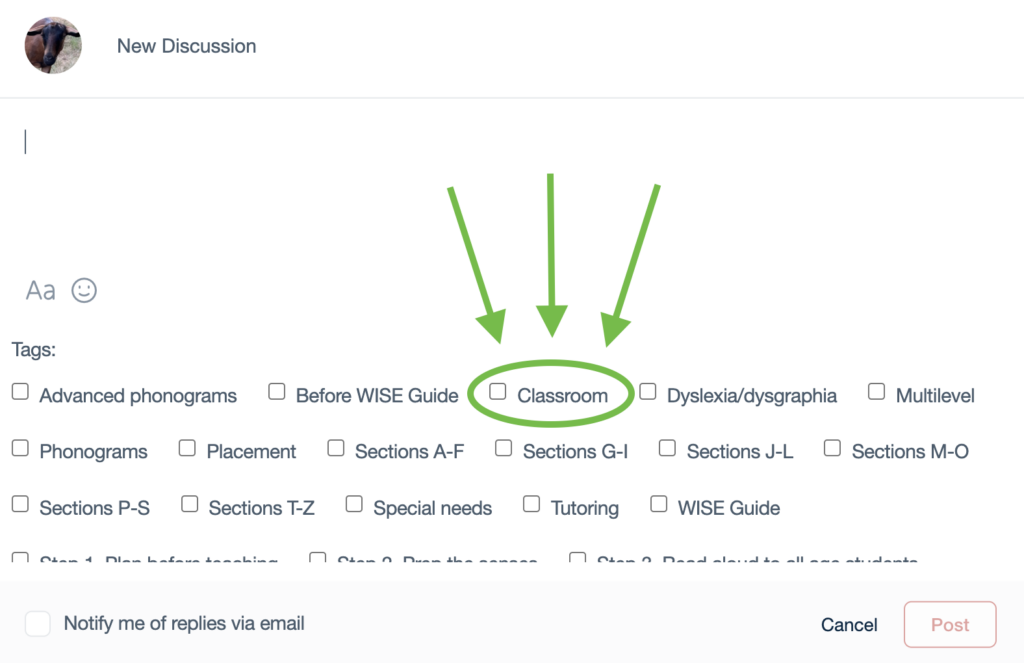
- There is also a “classroom” tag in the Resource Center. Articles, activities, and more applicable to a classroom setting are found by searching and/or by clicking on the “classroom” tag button above the list of Resources.
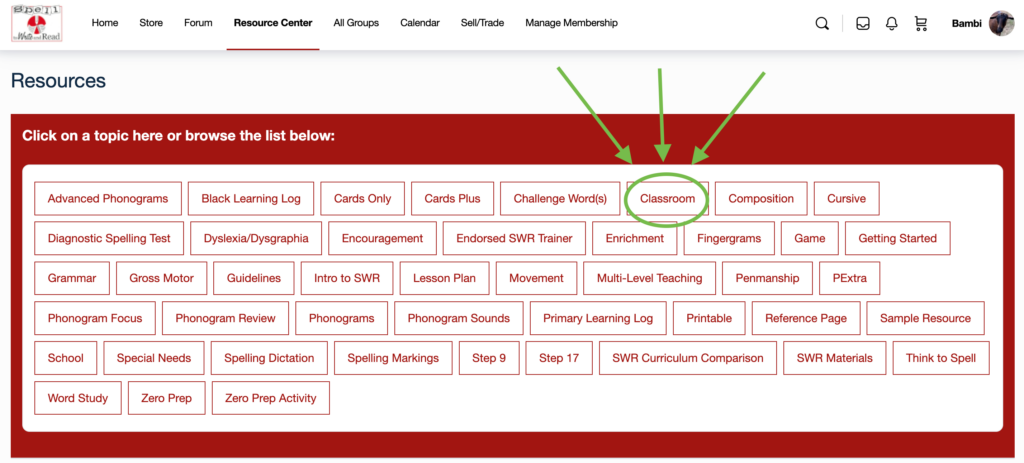
I’m a Forum Member but I can’t post in the Forum. Help, please?
If this is happens, please email admin@spelltowriteandread.com. There may be a setting in your account that did not automatically change if you converted from a Free Preview account. Thank you for your patience.
Do I have to be a Premium Member to post in the Forum?
No, Forum Members may interact in the Forum as well as Premium Members.
If you are a Forum Member and are unable to post in the Forum, please email admin@spelltowriteandread.com.
SWR Resource Center
Can I print a Resource for my friend or my fellow teacher across the hall?
If you and your friend or fellow teacher maintains a Premium Membership, then yes!
If the person you want to share a Resource with does not have a current Premium Membership, please do not share.
Consider Guideline #4. Any downloads and/or screen captures are for personal use in the Member’s home and/or classroom; they are not to be shared. Please don’t steal.
Thank you!
Are there Resources specifically for classroom teachers?
Yes! The SWR Forum & Resource Center offers two features for SWR classroom teachers!.
- There is a “classroom” tag in the Resource Center. Articles, activities, and more applicable to a classroom setting are found by searching and/or by clicking on the “classroom” tag button above the list of Resources.

- In the Forum, there is also a classroom tag to select when posting any new discussion. This allows searches for “[any SWR topic] classroom” to generate a list of Forum discussions pertinent to classroom teachers.

Membership
I’m a Free Preview Member or Forum Member. How do I upgrade?
Log in then click “Manage Membership” in the banner. Click “Select” for the level you want to join. For the Premium Membership level, there will be an option to choose monthly or yearly renewal.
Do you offer group or school discounts?
Yes! The Group Purchase option allows anyone to purchase six annual Premium Memberships for the price of five.
- Click on Group Purchase on the Home page.
- Fill out the form and pay.
- A code good for 6 uses will be sent to your email (check spam folder).
- Share the code with your group of six members.
How do I redeem my group purchase code or discount code?
Note: If you are already a Premium Member, you may need to change to a Forum Membership then follow this procedure to enter your discount code.
1. Log in to your account. (This should work from any account type.)
2. Click “Manage Membership” in the top banner.
3. To the right of “Premium Member,” click the Select button.
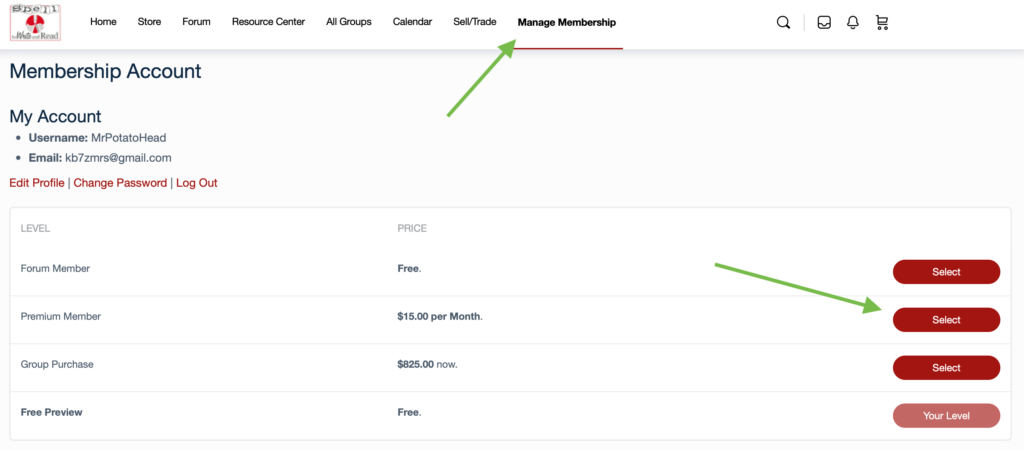
4. Scroll down and “Click here to enter your discount code.”
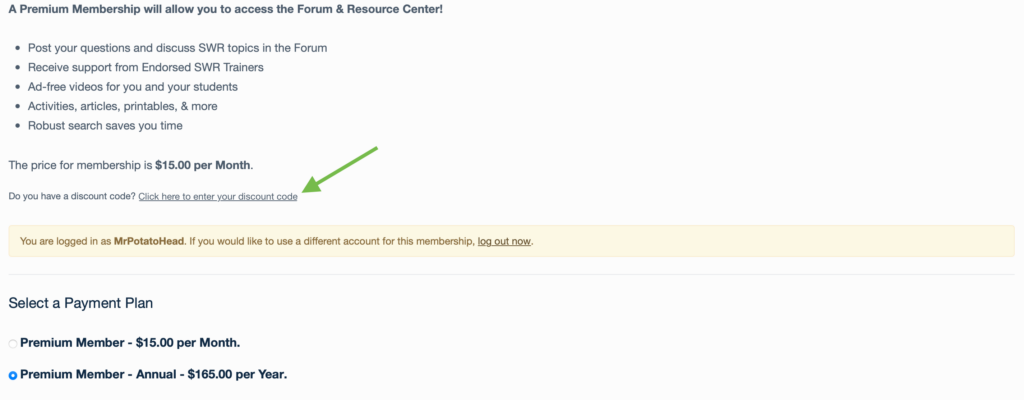
5. Click there, type in your code, and click “Apply.” The price for membership above where you entered your code with change to $0.00.

6. Select Annual, agree to the Terms of Service, and click to submit your order.
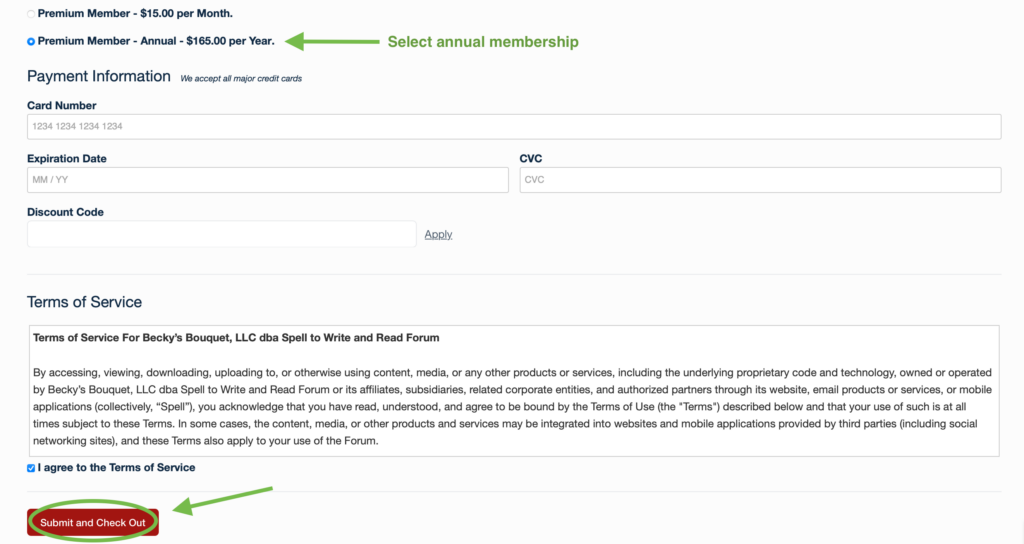
Welcome to the SWR Forum & Resource Center!
My card expired. How do I update my payment information?
How do I cancel my membership?
Canceling your membership will change your account back to “view only.” You will still be able to login and see the SWR Forum. You will still be able to read the Forum. You will not be able to start discussions or post replies. If you have difficulties with this, please email admin@spelltowriteandread.com.
Do you offer refunds?
You may cancel your membership at any time, for any reason, by following the instructions on the Website. If you cancel your membership before the end of the applicable billing cycle, you will not receive a refund for the current billing period. Access to the site ends the moment you terminate your membership.
If you have extenuating circumstances, please reach out to us.
I’m having trouble logging in. Who can help?
Please email us: admin@spelltowriteandread.com
SWR App
What is happening to the SWR app?
The SWR app will no longer be available. Spell to Write and Read is seeking a developer to build a new app.
Miscellaneous
What happened to BHI Books and who is publishing SWR?
Gary and Wanda Sanseri formerly self-published Spell to Write and Read and other works through their business, Back Home Industries, Inc. The Sanseris sought to retire from publication and distribution. In May 2023, they named Becky’s Bouquet, LLC as the exclusive publisher of SWR materials. Products are sold here in the official company store and resold by some SWR Endorsed Trainers, independent booksellers, and other places where curriculum is sold. Click here to read more.
How do I contact someone about this site?
If your question was not answered above, please email admin@spelltowriteandread.com
If your question pertains to the store, please email sales@spelltowriteandread.com
You may contact us by mail at:
1740 Shaff Rd #108
Stayton, OR 97383

